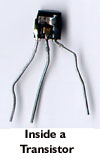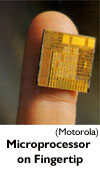|

|
Introduction
 The
development of the transistor and integrated circuits is one of
the most important technological achievements of the twentieth century.
Radio, television, long-distance telephones, and computers were
developed using vacuum tubes and electrical relays, but with the
development of the transistor and integrated circuits, electronic
devices became smaller, more efficient, more reliable and more affordable.
Digital electronic devices can now be found everywhere: in home
appliances, automobiles, ships, airplanes, wristwatches, calculators,
super computers, desktop computers, portable computers, communications
satellites, robots, automated factories, recording studios, home
theatres, the film and television industry. The
development of the transistor and integrated circuits is one of
the most important technological achievements of the twentieth century.
Radio, television, long-distance telephones, and computers were
developed using vacuum tubes and electrical relays, but with the
development of the transistor and integrated circuits, electronic
devices became smaller, more efficient, more reliable and more affordable.
Digital electronic devices can now be found everywhere: in home
appliances, automobiles, ships, airplanes, wristwatches, calculators,
super computers, desktop computers, portable computers, communications
satellites, robots, automated factories, recording studios, home
theatres, the film and television industry.
The semiconductor
industry began shortly after World War II when researchers at Bell
Labs (now Lucent) in New Jersey,
USA, invented the first primitive transistors. Their discoveries
arose from research into the atomic structure of a class of elements
known as semiconductors.
The simplest
semiconductor device is the diode. It
has many applications in electronic circuits because it permits
electricity to flow through it in only one direction.
 In
the 1950s, when transistor radios first appeared, the most common
form of transistor was the bipolar transistor.
It could be used as an amplifier or as an electronic switch. At
that time each transistor had to be packaged in its own small container
with three wires or leads which were soldered together to make complex
circuits. In
the 1950s, when transistor radios first appeared, the most common
form of transistor was the bipolar transistor.
It could be used as an amplifier or as an electronic switch. At
that time each transistor had to be packaged in its own small container
with three wires or leads which were soldered together to make complex
circuits.
By the 1960s,
following the lead of Jack Kilby at Texas Instruments and Robert
Noyce at Fairchild Semiconductor, semiconductor manufacturers were
developing techniques which allowed them to create several transistors
on one piece of silicon - the integrated circuit. With dozens, then
hundreds, and today millions of transistors crammed into one tiny
piece of silicon, family of more energy efficient transistors -
field-effect transistors - also had to be
developed.
NEXT
|
